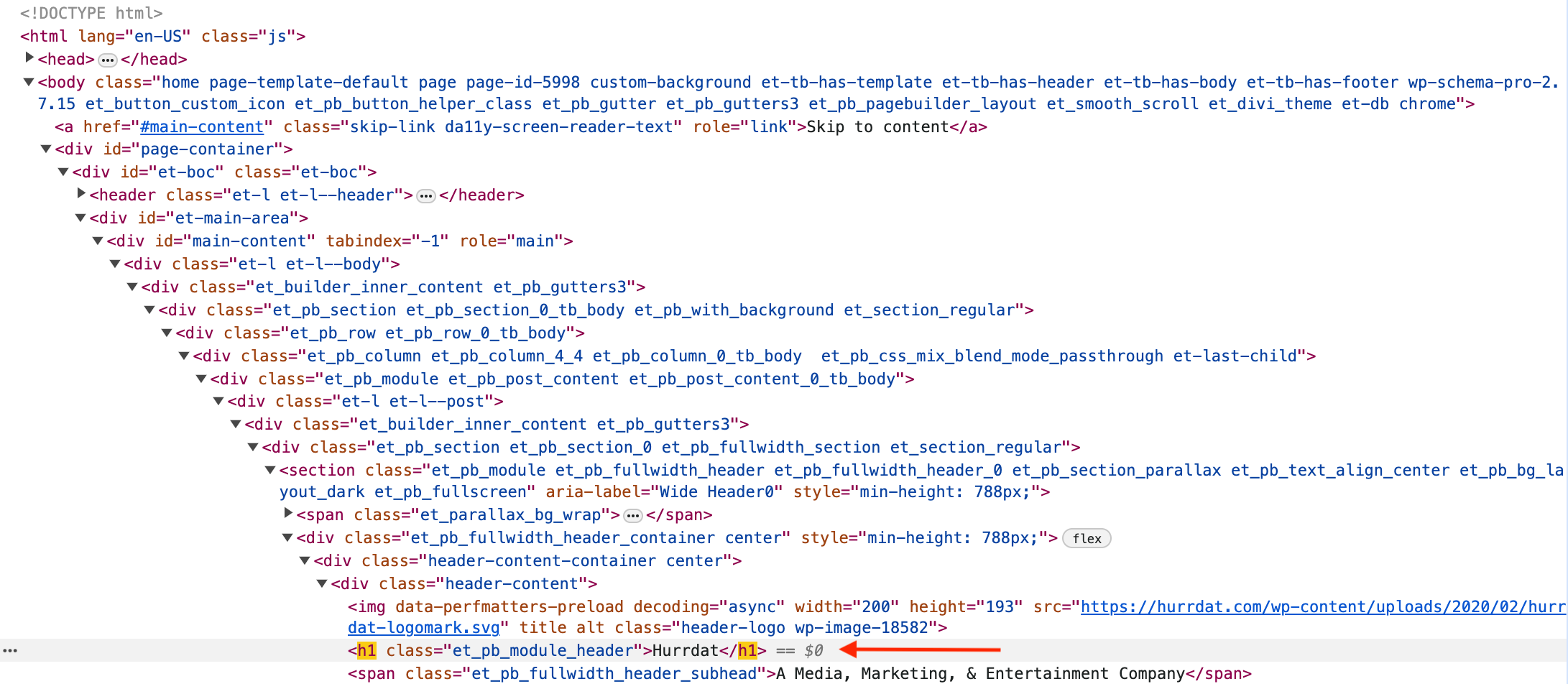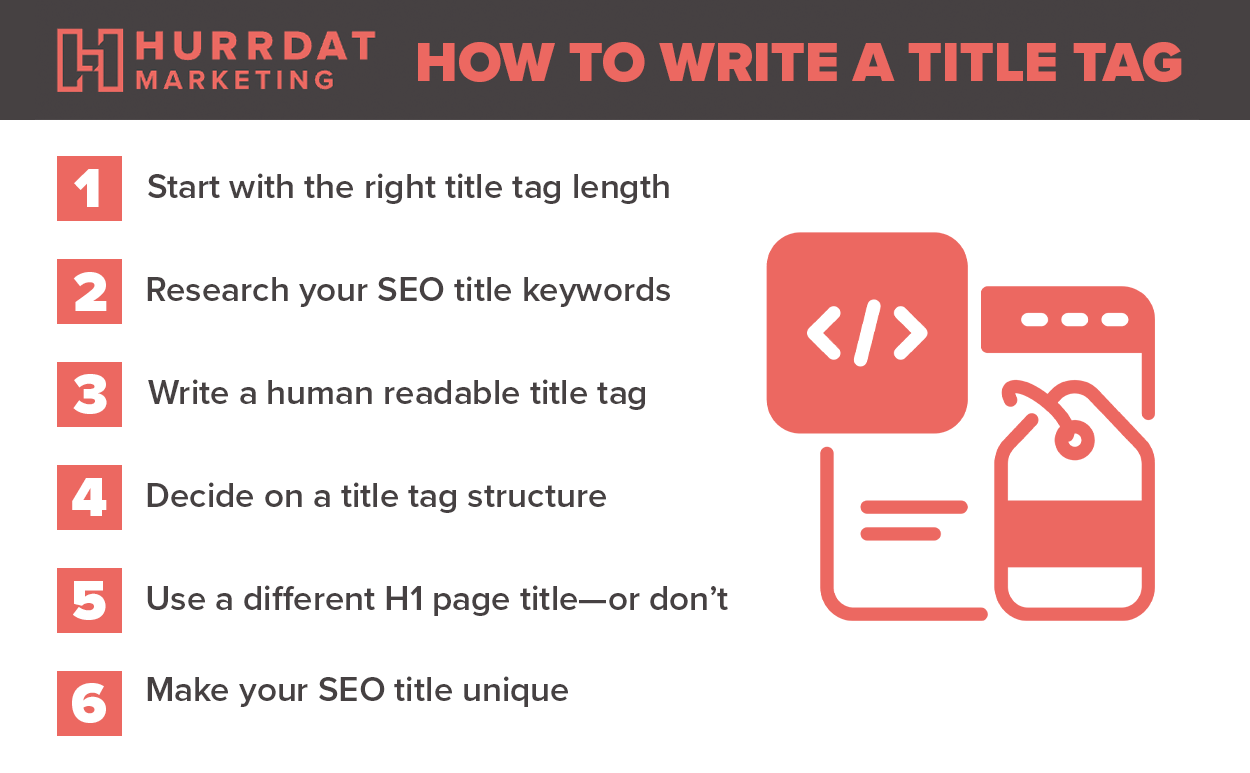Title tags are a clear, concise description that tells both search engines and users exactly what your page is all about. They could make the difference between earning more clicks to your website and losing potential customers to your competitors. Read on to learn more about why you need title tags for SEO and how to write strong SEO titles that rank.
- A title tag is a form of HTML markup that labels your page title for SEO purposes
- Title tags are also known as SEO titles, meta titles, or SEO page titles
- An optimized title tag can make it easier for search engines to index your page and lead to better click-through rates, user experience, and brand recognition

What Is a Title Tag?
A title tag is a line of HTML code that tells search engines and internet browsers the title of your page. A title tag can also be called an SEO title, meta title, or SEO page title. You’ll see title tags in Google search, in your browser tab, and on link previews for social media posts.



Title Tag vs H1 Tag
SEO title tags and H1 header tags are different in two major ways—how they’re coded and where they appear.
SEO titles use the <title> tag found under the broader <head> tag in HTML, and they only show up in search engine results.


H1 page titles use the <h1> tag found under the broader <body> tag in HTML, and they only show up on the page.


While both are important to include for SEO purposes and a positive user experience, title tags are the initial hook to get searchers to visit your page and H1 titles reassure them that they’ve landed in the right place.
Why Are Title Tags Important for SEO?
 As part of your on-page SEO, optimized title tags are essential to your overall SEO strategy. Here are a few reasons why it’s important to have an optimized meta title.
As part of your on-page SEO, optimized title tags are essential to your overall SEO strategy. Here are a few reasons why it’s important to have an optimized meta title.
Help Search Engines Index Your Website
To display your webpages in the right queries, search engines must first crawl and index your site. In this process, your title tag is one of the major on-page elements that search engines, like Google, use to understand your content and what it answers. If you properly optimize your title tags, you have a better shot at ranking in more relevant search results.
Increase Click-Through Rate
For a higher click-through rate (CTR), details matter. Title tags that are specific and differ from competitors better draw customers’ interest and lead to more clicks. Unlike nondescript title tags that simply state the webpage’s purpose, simple changes—like adding in pricing information—can increase CTR from 0.65% to 1.23%, as was the case for our client Extra Space Storage.
Improve User Experience
SEO titles help people decide which entry they’ll click on in search results. An accurate, descriptive title tag lets searchers know exactly what to expect before they choose your website. The more relevant your title tag is to the content on your page and the more directly it answers common search intents, the more likely you are to catch the attention of searchers and satisfy their needs.
Boost Brand Recognition
Every title tag should have your brand name in it. That way, searchers know they’re getting information from a reputable source. Even if they don’t click on your link, they’ll still learn you exist and might consider you when they’re ready to purchase later on. This strategy works especially well for pre-launch awareness and visibility campaigns like Hurrdat Sports Bar & Grill’s opening that resulted in 38,600 impressions in search.
How to Write Title Tags for SEO
 There isn’t one correct way to write SEO title tags. Sure, Google and other search engines have guidelines about ideal length, structure, and keyword optimization. But ultimately, this on-page SEO tactic is about testing what performs best for your website. Based on over ten years of experience, here are our best practices for writing title tags that rank in search results.
There isn’t one correct way to write SEO title tags. Sure, Google and other search engines have guidelines about ideal length, structure, and keyword optimization. But ultimately, this on-page SEO tactic is about testing what performs best for your website. Based on over ten years of experience, here are our best practices for writing title tags that rank in search results.
Start With the Right Title Tag Length
The ideal SEO title length is around 50 to 60 characters. It’s possible to go over this title tag character limit without penalization, but staying within these parameters helps prevent Google from truncating your SEO page title in search results. To stay within the title tag character limit, focus on writing clear, concise copy and using symbols in place of words that take up more character space—for example, replacing “and” with the ampersand (“&”). As a more advanced title tag optimization tip, use symbols that require less pixels (like “|” instead of “—”) to condense your title tags.
Your title tag shouldn’t be too short or missing entirely, either. If it’s missing, Google will make up one for you that you have no control over. And if your SEO title is too short, you run the risk of missing out on extra keyword opportunities and appearing too vague to searchers.
- Bad: About | Nebraska Realty
- Good: About Nebraska Realty – Full Service Real Estate since 1993
The first title tag example is too short and unspecific. It also lacks keywords. The second title tag provides better context for who the business is and what services they provide with keywords that target a specific search intent.
Research Your SEO Title Keywords
Without keywords in your SEO title, you won’t rank for as many searches, and Google will have a harder time knowing when to choose your website for specific search terms. Because you have limited space in the title tag, one of the SEO title best practices is to use a “main” target keyword that encompasses the topic of your page. You can find your main keywords by looking at competitor websites, using free SEO tools, and conducting A/B testing.
Write a Human Readable Title Tag
Your title tag will only be effective if people are able to easily read it. Content that sounds robotic or automatically generated indicates a lack of effort, while human readable content suggests effort. This effort (one that prioritizes the user experience) is rewarded. So while SEO title best practices encourage keyword optimization, don’t spam the title with multiple keywords strung together with no connection, a black-hat SEO technique known as keyword stuffing. Instead, choose one “power word” keyword—or two if your main keywords are short and unique enough—to include in your title tag.
- Bad: Pratt Dental, Family Dentist, Nebraska Dentist, Dentist Near Me
- Good: Pratt Dental: General & Family Dentist in North Platte, NE
Decide On a Title Tag Structure
Should your unique selling proposition or page title come first? Play with the order of your title tags and use A/B testing to find your best-performing SEO title structure. It’s typically best to place your brand name at the end of your title tag after a colon, comma, or “pipe” (“|”) so that users don’t lose important context should Google truncate your title tag and so that it’s not seen as duplicate content. Once you decide on the right title tag structure for your business, stay consistent across all other pages—it’ll improve your brand recognition!
Use a Different H1 Page Title—or Don’t
When it comes to title tags and H1s being the same, there’s some grey area. Search engines won’t flag your webpage for a matching SEO and H1 title. You’ll still have the same chances to rank, and you’ll still be targeting your main keywords.
However, having unique H1 and title tags gives you a chance to optimize your website for an additional main keyword. While the SEO title holds more weight in the eyes of search engines, the H1 tag is still a prominent factor, and placing another one of your main target keywords here can help you rank for that keyword as well. That said, they shouldn’t be radically different. Google will compare the two when making sure the title tag accurately describes what’s on the page, so you’ll want them to be similar and address the same topic.
Make Your SEO Title Unique
Your SEO title needs to be unique from the title tags on all your other webpages. If your titles across multiple pages are exactly the same, you run the risk of search engines flagging those webpages as duplicate content, which could lead to a lower search ranking. Emphasize the intent of the webpage first and then include your branding, not vice versa.
- Bad: Hurrdat Marketing | Search Engine Optimization Services
- Good: Search Engine Optimization Services | Hurrdat Marketing
Your SEO title also needs to be unique from competitors on the results pages. If every result is the same, what would make people want to click yours, especially if it’s not ranked in the top position? Identify what sets you apart from your competition and feature that unique selling proposition in your title tag. For a commercial truck insurance provider, your differentiator might be price or speed.
- Bad: Commercial Trucking Insurance Company | Ten Four
- Good: Commercial Truck Insurance | Get Same-Day Quote | Ten Four or Affordable Commercial Truck Insurance (from $59) | Ten Four
For other companies, creating a sense of urgency with action verbs (e.g., “don’t miss”) or specific adjectives (e.g., “free” or “limited-time”) might work better. Other differentiators you could test out in your title tags for your business’ blog include:
- Affordability: “Budget-Friendly Ideas…” or “Cheap Products…”
- Depth/Scope: “Step-by-Step Guide…” or “Beginner’s Guide…”
- Efficiency: “Quick Ideas for…” or “Easy Methods for…”
- Quantity: “4 of the Best Ways to…” or “16 Reasons You Should…”
- Recency: “…in 2024” or “…This Year”
Need help boosting your SEO strategy? Hurrdat Marketing offers content marketing and SEO services to advance your title tag and online marketing strategy. Contact our on-page SEO experts today to learn more!



